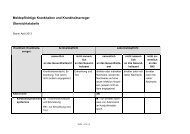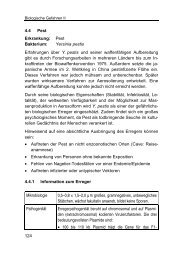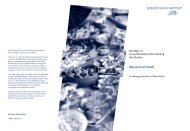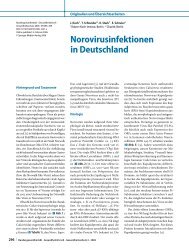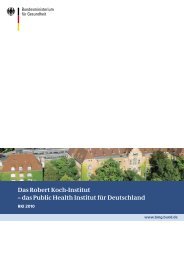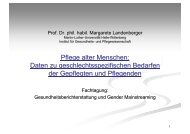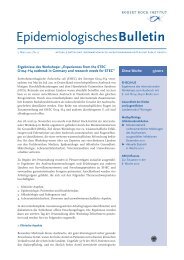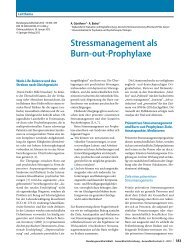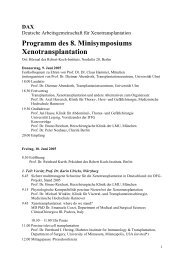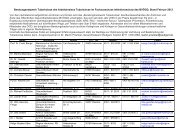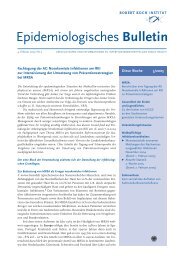Infektionsepidemiologisches Jahrbuch meldepflichtiger ... - RKI
Infektionsepidemiologisches Jahrbuch meldepflichtiger ... - RKI
Infektionsepidemiologisches Jahrbuch meldepflichtiger ... - RKI
Erfolgreiche ePaper selbst erstellen
Machen Sie aus Ihren PDF Publikationen ein blätterbares Flipbook mit unserer einzigartigen Google optimierten e-Paper Software.
Executive Summary<br />
This summary provides an overview of the outstanding<br />
developments and events in infectious<br />
disease epidemiology for 2010 and serves to introduce<br />
the reader to the following respective chapters<br />
of this year’s Annual Report, where further details<br />
and other relevant information about each infectious<br />
disease can be found. Comprehensive analysis<br />
and in-depth reports of important outbreaks are<br />
additionally published in the Epidemiological Bulletin<br />
of the <strong>RKI</strong> and in various scientifi c journals.<br />
In 2010 the number of Hantavirus illnesses<br />
reached more than 2,000, which is nearly ten<br />
times the number observed in the previous year.<br />
This is the highest fi gure seen since the introduction<br />
of the reporting system in accordance with the<br />
German Protection against Infection Act (IfSG)<br />
in 2001. Similar to trends in 2005 and 2007, the<br />
higher incidences were preceded by mild winters<br />
that were followed by a higher proliferation of voles,<br />
a known carrier of the Hantavirus.<br />
The number of cases of Dengue fever also<br />
reached a new peak in 2010, doubling the number<br />
compared to the previous year. Possible reasons for<br />
this may be the increased circulation of the virus in<br />
endemic areas within the last years, and further<br />
spread of related mosquito-vectors. The year 2010<br />
saw the fi rst autochthonous infections in Southern<br />
Europe, including a case diagnosed in Germany<br />
and infected in Croatia – until then not known to<br />
be a risk area.<br />
Hepatitis E also reached a new peak this year<br />
with twice the number of illnesses compared to<br />
2009. Of particular interest is the growing number<br />
of infections acquired in Germany, since this viral<br />
hepatitis has been historically considered an imported<br />
virus. The causes for this new trend have<br />
not yet been fully researched and understood.<br />
The number of cases of Adenovirus conjunctivitis<br />
in 2010 tripled compared to the previous year.<br />
The cause for this increase, which included outbreaks<br />
and sporadic cases and persisted at a lower<br />
level into the next year, remained unclear. Similar<br />
increases were observed in 2006, when the increased<br />
incidence remained unexplained as well,<br />
and in 2004, when an outbreak could be traced to<br />
several bases of the German Federal Defence Force.<br />
Executive Summary<br />
One of the most clearly defi ned outbreaks in<br />
2010 – with regard to time and area – involved Legionella<br />
in and around the twin cities of Ulm and<br />
Neu-Ulm. Intensive investigations identifi ed an air<br />
cooling system on the roof of an offi ce building<br />
to be the cause. There were 113 illnesses with 10<br />
deaths.<br />
Among rare infectious diseases in Germany,<br />
Cholera, Diphtheria, and Tularaemia showed the<br />
highest incidences since the introduction of IfSG.<br />
Regarding Cholera this was largely due to 4 siblings<br />
who fell ill upon returning from a trip to<br />
Pakistan, of which one infant died after arriving<br />
in Germany. For Diphtheria, an increase was observed<br />
particularly of autochthonous, skin-associated<br />
Diphtheria caused by C. ulcerans. No association<br />
could be determined among the 31 reported<br />
Tularaemia cases.<br />
Infl uenza continued to receive special attention<br />
in 2010. The abating pandemic wave of A(H1N1)<br />
2009 prevailed during the fi rst half of the year,<br />
followed by the onset of the seasonal wave at the<br />
end of the year, which was still dominated by<br />
A(H1N1) 2009, but also had a substantial proportion<br />
of infl uenza B virus.<br />
Among the noteworthy infectious diseases,<br />
HIV infections still keep a prominent place. The<br />
total number of fi rst-diagnoses stabilized further in<br />
2010, a shift to younger age groups was observed<br />
in the group of MSM (men who have sex with<br />
men).<br />
Data reported for invasive MRSA (Methicillin<br />
resistant Staphylococcus aureus) are for the fi rst<br />
time available for an entire year, making possible<br />
an assessment of the importance (and future<br />
trends) of this typically hospital-acquired pathogen.<br />
Measles maintained an important position<br />
among the vaccine-preventable diseases, not least<br />
because of the target of global eradication declared<br />
by the WHO. The increase in case numbers in<br />
2010 shows that Germany is still far away from this<br />
goal, likely due to insuffi cient vaccination rates. An<br />
increasing incidence in young adults warrants further<br />
careful observation.<br />
The analysis of reported cases of vaccine-preventable<br />
diseases can provide important indicators<br />
11




